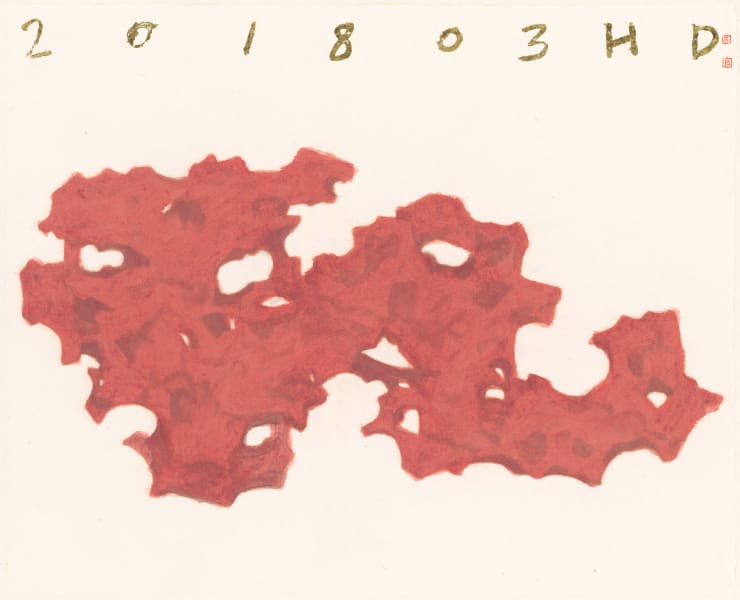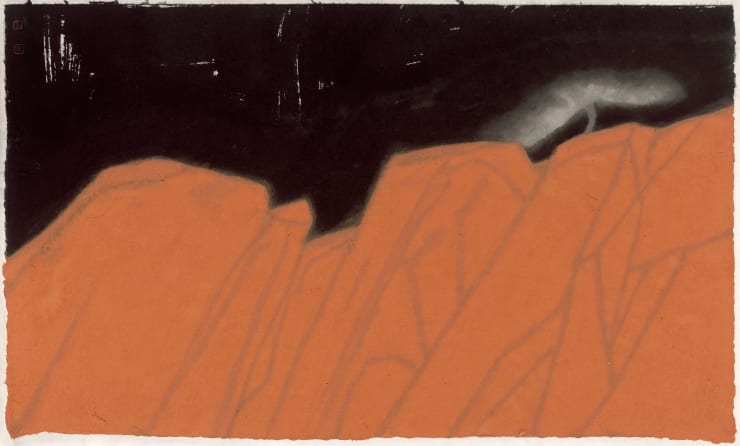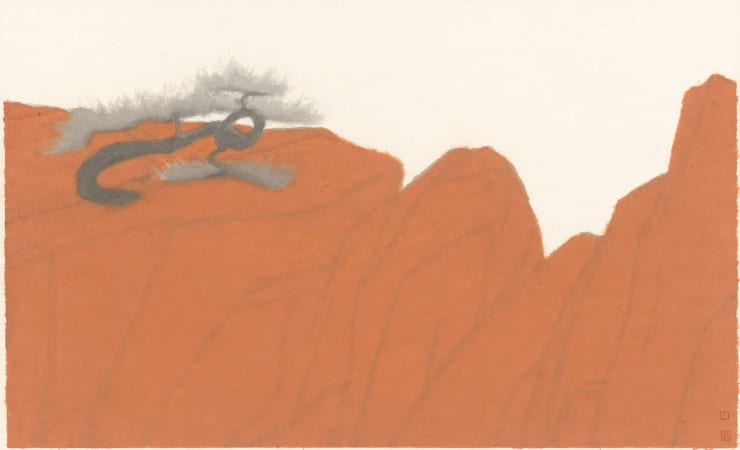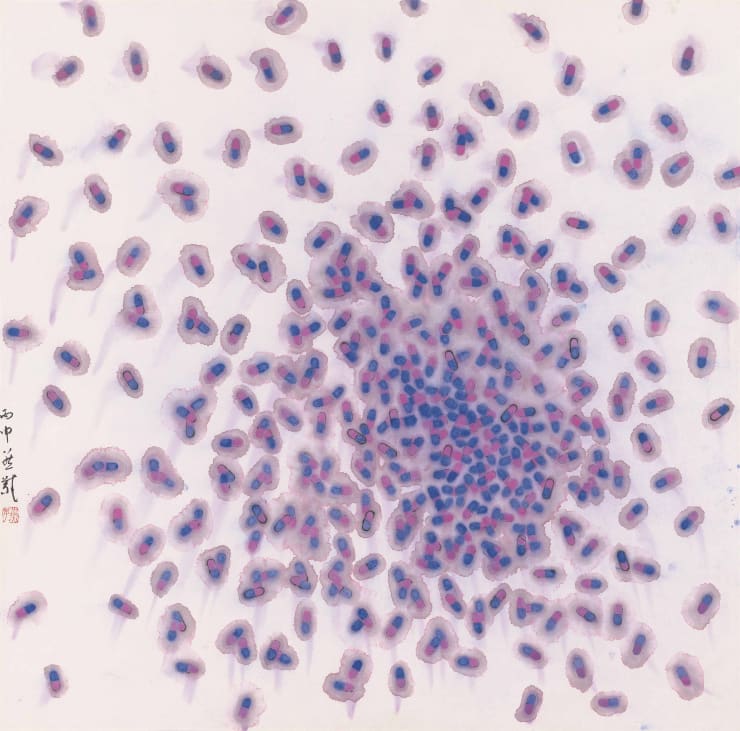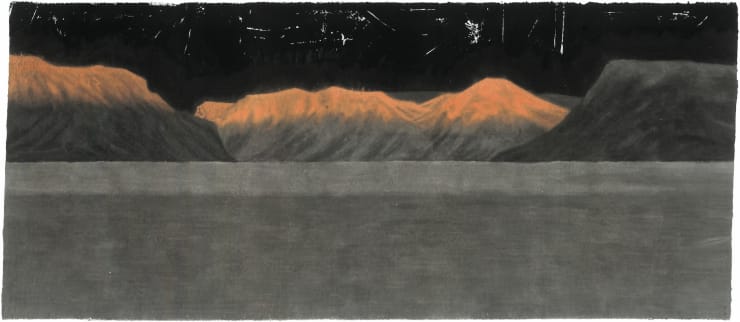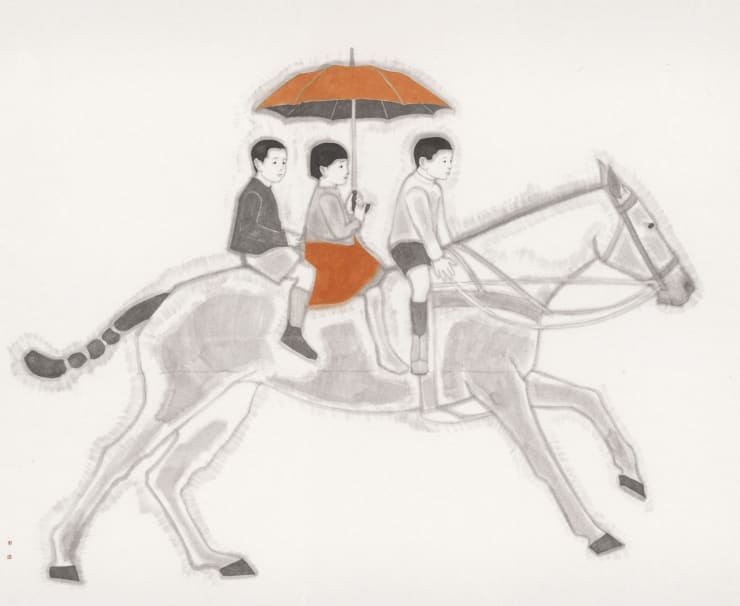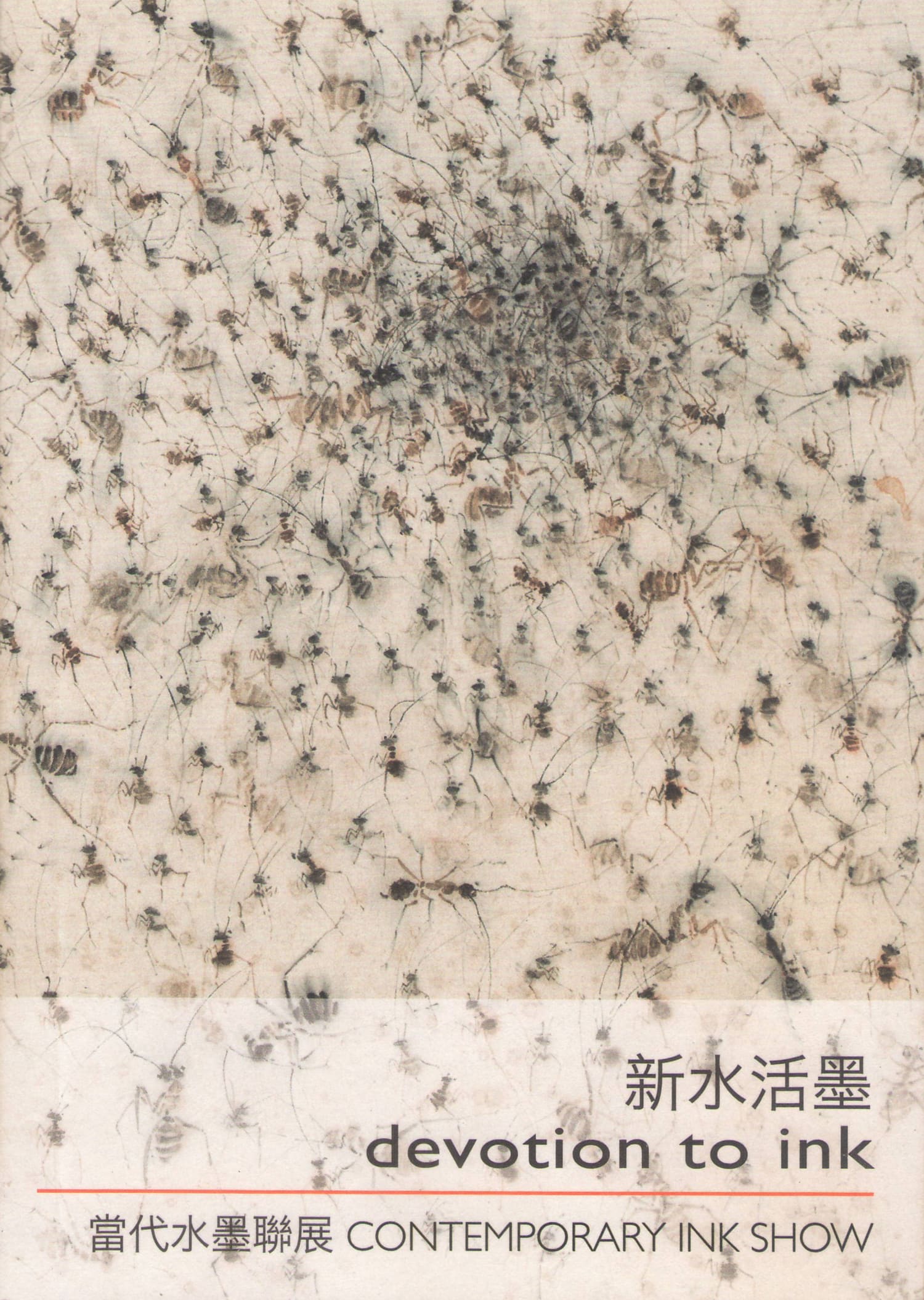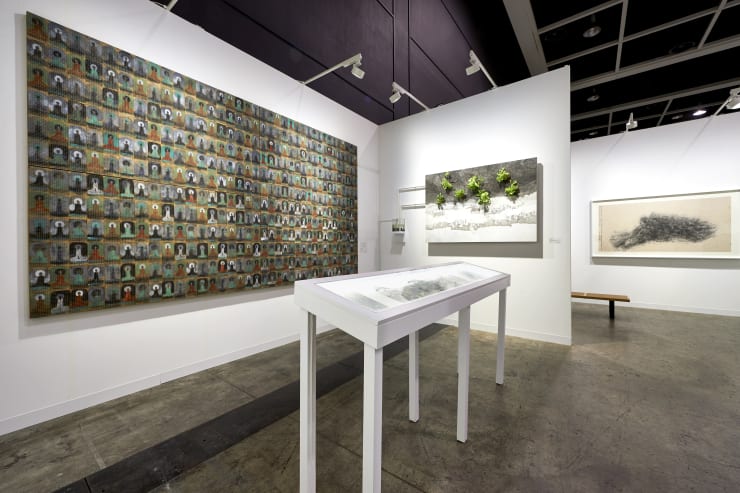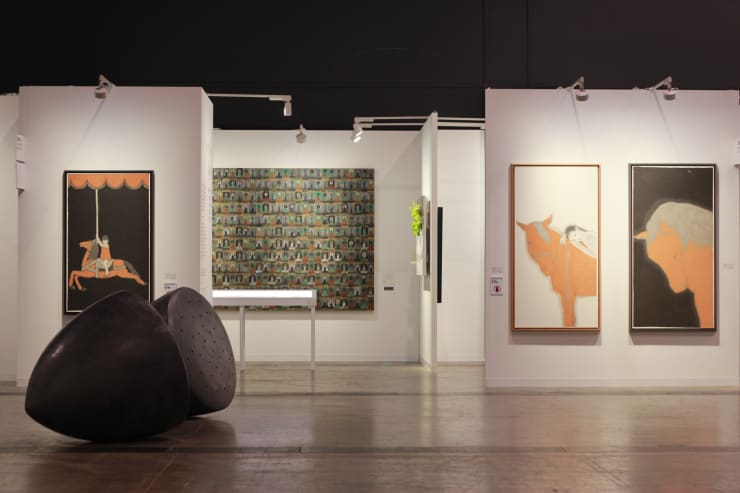Huang Dan 黃丹
Academic History and Early Exhibitions
Huang Dan was born in Guanxi, China, in 1979. Choosing to study art was part passion, part compulsion, driven by her yearning to capture the vibrancy and vigour of her surroundings. Moving to Beijing at once separated her from some aspects of the natural world, and affirmed her fascination with its strange beauty. She was in the capital to study at the Central Academy of Fine Arts: she graduated with a BA from the Department of Traditional Chinese Painting in 2001. In 2004, she was awarded an MA from the same institution.
Marking her official debut into the art world, her first solo exhibition was the Scent of a Woman exhibition in Seoul in 2006. This event took place simultaneously with a group show entitled The Seventies Ink Exhibition at the Yanhuang Art Museum, Beijing. The group show featured Huang Dan alongside other artists born in the 1970s, including Peng Wei.
Exhibitions in Greater China
Huang Dan met with rapid acclaim and recognition from both academics and collectors. Since 2006, she has taken her contemplations of landscapes, animals and humans across Greater China, with a particular emphasis on Beijing, Shanghai and Nanjing. Her Beijing exhibitions included Four Square Exhibition on Inheritance of Chinese Contemporary Art at the Today Art Museum in 2009, Strength – Youth Ink Painting Exhibition at the same museum in 2011, Ink Dazzle at the Millennium Monument Museum of Art in 2012 and Shuimo: Meet Revolution, the New Silk Road at the Beijing Minsheng Contemporary Art Museum in 2015.
Exhibitions in Shanghai / Nanjing included The New Term of Ink Painting at the Shanghai Art Museum in 2011, International Hand Scroll Masters Exhibition at Cheng Huai Tang and Quietism of Master – Invitational Exhibition of Young Contemporary Ink Painting Masters at the Jie Mo Art Center, both in Nanjing in 2012.
In Hong Kong, Huang Dan has exhibited previously at the 2014 Devotion to Ink at the Maritime Museum, the Cha-Naat Art Basel Hong Kong in 2016, and Perceptions at Art Basel Hong Kong in 2017. Cha-Na the fleeting, impermanent moment in time captured through the patient discipline of the brush, is a concept that has echoes in the inert, coiled strength of Huang Dan’s work.
The artist also exhibited in Tokyo in 2011 and Taipei in 2013 and 2014.
Artistic Themes
Followers of Huang Dan’s work will notice significant and recurring motifs within them: young children, horses and acrobats, carefully positioned in a natural world with expanses of dream-like azure water, sinewy trees and black skies.
Huang Dan describes the horse in the language of classical Chinese painting. The horse is “stable as a mountain, and the horse's eyes are as clear water. Painting a horse is like painting an animal's "landscape." In earlier paintings, when the artist was conveying narrative, horses tended to be grouped with children. Increasingly, animals (including the horse) are seen alone in paintings. As the artist puts it: “I no longer need works with narrative and plot. The horse became the only protagonist.”
Children also continue to be a feature in her recent works. For example, Season of Confidences depicts children in close, yet unsentimental togetherness, caught in an unguarded moment of serene inactivity. The emptiness, the neutral blankness of the expression is another resonant feature of Huang Dan’s painting. The viewer’s subconscious reflex is to project his or her own emotions onto the scene to fill the apparent emotional void.
The artist hints further at the increasingly narrative-free tendencies of her works, the opening out of her characters and situations to subjective interpretation by the audience: “I wanted to paint what is vibrant… wanted the painting to be as fruitful as possible. But now, gradually, the human beings have no character any more, no facial expressions, no background. They don’t even act as the main character.” This type of realism also serves as an acknowledgement that most of us are rarely to be found at the centre of the action, but often on the sidelines, waiting, poised between episodes of significance.
The scenic backdrops of Huang Dan’s paintings are familiar to all of us, and yet rendered unfamiliar by their depictions in her paintings: static, immobile, impenetrable. These landscape features are inspired by the nature of the artist’s everyday life. They form a constant presence in her mind, and a companion to her thoughts: “It’s impossible not to keep thinking of them since I see them every day.”
Huang Dan is keenly alert to her surroundings – a scenery both known and yet still to be discovered. She is a watcher, an observer of the world in the same spirit as her painting: “Sentinel.” The sentinel watches what we cannot observe, and the emptiness of the landscape suggests that there is little that he can see. Thus the sentinel becomes a watcher of himself, turning his eye inwards in a journey of self discovery. Huang Dan spent several weeks in Scandinavia in 2016, noting parallels between her lanscapes and that of Norway and Sweden. Scandinavia was not so much an influence of her work, but a corroboration of her imaginings. For her, scenery is as much mental as natural.
As Huang Dan remarks: “It is because of my curiosity about myself that I explore the world: this self exploration drives me to see more and more. The scenery is unique. It’s like standing on the cliff looking down from a point of view that only you can see. This kind of feeling… makes me want to continue.”
Future Development
Huang Dan’s works presented at Ink Asia in 2017 shows the tree centre stage, becoming more convoluted, twisted, seething with life.
Human form is physically eliminated; in its place trees take on not just a physical force, but a psychological complexity. They are static, yet active: a coiled spring of energy. The tight focus on tree roots denotes the artist’s continued journey towards abstraction, achieving the realization of life, whilst only delivering a partial fragment.
The simplicity that is a theme of Huang Dan’s works is manifested most clearly in her sparing use of colour, offering the viewer clean signature shades of a cold blue and hot orange, black and white. The artist offers us a clue as to how this selective colour palette may yet narrow further in the future: “The colours are becoming even more simple. Maybe in the end it will just be black and white. And then I may turn away from black and white and lead us into a world of chaos…” She describes the simplicity in the context of a half way stage between full, vibrant representation and the portrayal of nothingness. “A process from much, to half, to less… to none.” Huang Dan continues: “But nothingness is not about an empty canvas, it’s about finding the truth. So it’s not a movement from being to not being. But it’s how to use what exists on the canvas to present untouchable, abstract disciplines… This is something difficult but worthwhile.”
Huang Dan pushes on her impressionist instinct of stripping away extraneity, further reducing colours and forms to focus on the essentials. Her newest paintings affirm the continuation of her journey towards the core of our lives. Where impressionism softened the lines and blurred the contours of newly industrialized life, Huang Dan takes the philosophy a stage further, defining lines and angles of physicality, whilst leaving a tinge of emptiness in expressions, and removing background details entirely.
Seeing Huang Dan’s oeuvres in the light of impressionist forerunners helps to frame the artist as an innovator in a path of European innovation, while her reworking of traditional Chinese motifs such as pine needles and mountainous landscapes, portrays her ability to apply Monet’s ideas within her own cultural background. When she imbues the pine needles with a concerted energy, radiance and clarity, rather than individual detail, she works in the spirit of impressionist influence; she also asserts her bold yet harmonious vision of the past, presenting forward movement from her inspirations rather than a radical schism.
Currently living and working in Beijing, Huang Dan has a sense of excitement about the future. This thrill is born of the equilibrium she has reached through maturity and a calm family environment, anchored in motherhood. As she puts it: “When you are sure that the main meaning of the life is fixed, then it brings focus and a sense of readiness for the adventures and challenges of the future. The future is uncertain, and everything is possible.”
-

Semper Femina
18 Juillet - 20 Août 2023Ora-Ora is pleased to announce a group show of entirely female artists, comprising contributions from Peng Wei, Huang Dan, Zhang Yanzi and Nina Pryde. The title is “Semper Femina.” Semper...Lire plus -

KIAF SEOUL 2022
2 - 6 Septembre 2022Ora-Ora is pleased to announce its first participation at Kiaf SEOUL in September 2022. This is the first occasion Ora-Ora has presented an exhibition in South Korea. Ora-Ora’s debut at...Lire plus -

When You Rise
29 Juin - 14 Août 2022Ora-Ora is pleased to announce a thrilling new solo show by Beijing-based artist Huang Dan at its Tai Kwun gallery in Hong Kong. The show runs from June 29 to...Lire plus -

Art Basel Hong Kong 2022
Where the Heart Is 25 - 29 Mai 2022Ora-Ora is pleased to announce an exciting line-up of artists for its forthcoming presence at Art Basel Hong Kong 2022 (Booth 1D33 ). The chosen artists are Huang Dan, Peng...Lire plus -

Art Basel Hong Kong 2021
Unlimited 19 - 23 Mai 2021Ora-Ora is pleased to present Unlimited , a group exhibition by contemporary artists Ma i Miyake, Zhang Yanzi , Huang Dan, Peng Jian, Xiao Xu and Juri Markkula . The...Lire plus -

Lagom
29 Octobre - 18 Novembre 2020Ora-Ora is pleased to present Lagom , a group exhibition that will feature works by gallery artists Chan Keng Tin, Huang Dan, Erik Jeor, Liu Qi, Cindy Ng, Patrick Nilsson,...Lire plus -

Unscheduled
Huang Dan 17 - 27 Juin 2020Organised in response to these unprecedented times, UNSCHEDULED comes together as a showcase of Hong Kong galleries, organised by Hong Kong Art Gallery Association (HKAGA) and taking place from 17...Lire plus -

Art Basel Hong Kong 2019
A.I. - Abstract Intelligence 27 - 31 Mars 2019What is A.I.? Firstly, we may think of artifical intelligence; that calculating rationality of machines, often a cinematic cue for scenes of dystopian badlands, seething with robots, relentlessly grinding humanity...Lire plus -

Taipei Dangdai
Black: Recategorize 17 - 20 Janvier 2019We are delighted to participate in the inaugural edition of Taipei Dangdai with the curated show Black: Recategorize , where we will present the works of Juri Markkula, Huang Dan,...Lire plus -

ART021 Shanghai Contemporary Art Fair
8 - 11 Novembre 2018Collectors' Preview | Thursday, 8 November, 2018 from 2:00-8:00PM Friday, 9 November, 2018 from 1:00-9:00PM Public Days| Saturday, 10 November, 2018 from 11:00AM-6:00PM Sunday, 11 November, 2018 from 11:00AM-6:00PM Location...Lire plus -

Nature Speaks
19 Octobre - 14 Novembre 2018Galerie Ora-Ora is proud to present Nature Speaks. From the seventeenth century genius of Claude Lorrain and Nicolas Poussin, into the 19th Century with self-taught artist Winslow Homer and ground-breaking...Lire plus -

INK ASIA 2018
28 Septembre - 2 Octobre 2018Private Preview | Friday, 28 September, 2018 from 4:00-6:00PM Vernissage | Friday, 28 September, 2018 from 6:00-9:00PM General Opening Hours | Saturday 29 September, 2018 from 11:00AM-7:00PM Sunday 30 September,...Lire plus -

Black: Recategorize
6 Septembre - 13 Octobre 2018Galerie Ora-Ora is delighted to present a group exhibition which seeks to challenge the audience perception and ask the question: ‘What is black?’ Bringing together works by seven pioneering artists...Lire plus -

Inspirations
17 Mai - 16 Juin 2018Following the successful solo debut of emerging Chinese painter Huang Dan at Galerie Ora-Ora in 2017, the gallery will present the female artist’s most recent works in Inspirations. Presented at...Lire plus -

Art Basel Hong Kong 2018
Leap to Light 27 - 31 Mars 2018In 'Leap to Light,' Galerie Ora-Ora channels the opposing forces of the modern world into the springboard for forward momentum. Our artists will harness the power of the leap and...Lire plus -

INK ASIA 2017
15 - 17 Décembre 2017At Ink Asia 2017, Galerie Ora-Ora initiates a synesthesia of sculpture and ink. Seeing one, we feel the other. We invite you to experience the meditative balance of Will Clift’s...Lire plus -

ART021 Shanghai Contemporary Art Fair
8 - 12 Novembre 2017Galerie Ora-Ora's show The Invisible Thread forms a landscape of our age: Will Clift's forms emphasize how line and space may become integrated into modern humanity, into our sense of...Lire plus -

Art Basel Hong Kong 2017
Perceptions 23 - 25 Mars 2017In current society, our perceptions, as a reflection of the soul’s independence are often overlooked and marginalized, whether methodically silenced through self-censorship and peer pressure, or voluntarily surrendered to skin-deep...Lire plus -

Boundary - Huang Dan Solo Exhibition
15 Février - 13 Mai 2017Is the end of the narrative when the real adventure begins? Pairings, partnerships, families – the narrative torrent of life streams along familiar lines. There is little resistance to the...Lire plus -

INK ASIA 2016
15 - 18 Décembre 2016Galerie Ora-Ora invites the visitor on a journey of celebration into the rich imaginations of our pioneering contemporary ink artists. Artists committed to actualizing their most modern, vivid dreams through...Lire plus -

Art Basel Hong Kong 2016
Cha-Na 22 - 26 Mars 2016Cha-Na is the study of the instance, its nature, importance, reflections, iterations and incarnations. Philosophers believe the instance is sacred and has fundamental importance to understanding the existence of the...Lire plus -

Cha-Na
21 Mars - 23 Avril 2016For this year’s Art Gallery Night, Ora-Ora will present “Cha-Na” as a continuation of our exhibition at Art Basel Hong Kong 2016. Cha-Na is the study of the instance, its...Lire plus -

Devotion to Ink Contemporary Ink Show
17 - 19 Mai 2014With over one thousand years of history, ink art has evolved from traditional ink to create a contemporary aesthetic standard and visual experience. In harmony with Art Basel Hong Kong,...Lire plus
-

HUANG DAN’S MONET-INSPIRED CONTEMPORARY INK LANDSCAPES
Mai 19, 2018Zolima CityMag Why we recommend it: Guangxi-born, Beijing-based artist Huang Dan’s works are infused with the dreamy colour palettes and forms of the impressionists, while...Lire plus -

The 20 Best Booths at Art Basel in Hong Kong
Mars 22, 2016Artsy After a stint in the fair's Insights section last year, Ora-Ora graduates to Galleries with a curated exhibition, 'Cha-Na.' Addressing ideas around instantaneousness and...Lire plus -

Art Big Bang: March
Mars 11, 2016Hong Kong 01 More than 3 billion years ago, the universe is but a micro singular dot of measureless weight. There is no starry sky,...Lire plus






